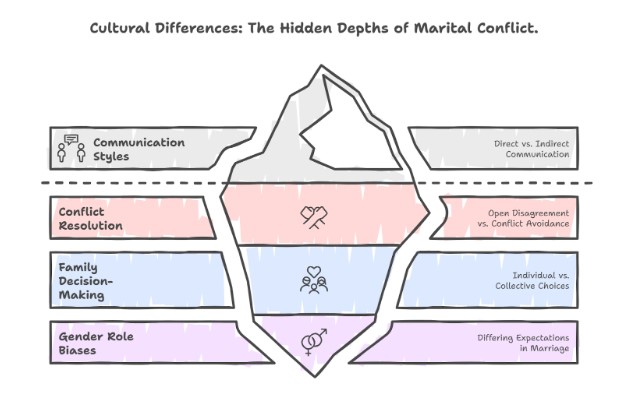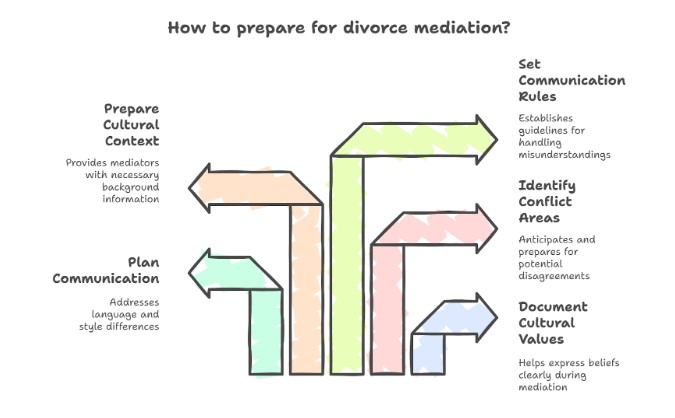Chicago brings together people from diverse cultures, and when marriages end, these cultural differences can create unique hurdles during divorce mediation.
Cross-cultural communication in divorce mediation involves navigating cultural values, emotional expression styles, and language barriers to reach mutual understanding and fair agreements.
Chicago divorce mediators meet couples from diverse backgrounds every day. They help people find common ground, even when communication styles clash.
When spouses come from different cultural or religious traditions, even minor misunderstandings can escalate into significant conflicts during mediation. What feels like honest talk to one person might come off as rude to another.
These gaps influence how couples discuss child custody, finances, and future living arrangements. It’s not always easy to spot where things go off track.
Understanding cultural communication patterns sets couples up for smoother mediation sessions.
Mediators who recognize these nuances can effectively guide the conversation, ensuring that both sides feel heard and respected.
Key Takeaways
- Cultural values shape how spouses communicate and respond during divorce.
- Mediation helps avoid cultural bias and misinterpretation.
- Interpreters and cross-cultural sensitivity are vital for fair outcomes.
- Chicago offers strong support for multicultural couples navigating the divorce process.
Why Culture Shapes Communication During Divorce Mediation

Cultural backgrounds influence how people express emotions, make decisions, and manage conflict during mediation.
These cultural nuances can either create confusion or help communication, depending on how mediators handle them.
Examples Of Culture-Driven Clashes
Direct vs. Indirect Communication Styles often cause tension in mediation rooms. Some cultures value directness and straightforwardness, while others rely on subtle hints and nonverbal cues.
If one spouse says, “I want the house sold immediately,” their partner might see that as aggressive or even disrespectful, depending on their background.
Eye Contact and Respect also vary a lot. Western mediators often encourage direct eye contact as a sign of honesty, but in many Asian and African cultures, this is perceived as rude—especially when interacting with authority figures.
This difference can lead mediators to think someone is hiding something when in reality, they’re just trying to show respect. It’s a subtle thing, but it matters.
Decision-making processes show big cultural differences in family roles. Some cultures expect individuals to make their own choices, while others prefer input from extended family or elders.
Cultural misunderstandings can significantly hinder the divorce mediation process when one spouse seeks the family’s input and the other prefers privacy. That can slow things down and frustrate everyone.
Religious and Traditional Values shape expectations about marriage, divorce, and child custody. Some cultural backgrounds see divorce as shameful, while others view it as just another life event.
These views influence how couples discuss property division, parenting, and financial support during mediation.
Struggling to communicate across cultures? Anna Krolikowska assists multicultural couples in navigating respectful divorce mediation in the Chicago area. Contact us today to schedule.
Common Misunderstandings Between Culturally Diverse Spouses

Cultural differences can create significant barriers to effective communication during the divorce process.
These misunderstandings often stem from deeply ingrained beliefs about family roles, decision-making, and conflict resolution.
What Creates Friction
Communication Styles are a significant source of trouble. Some people expect direct talk, while others prefer hints or subtle body language.
For instance, one spouse might want everything spelled out. The other person might communicate with subtle cues, which can lead to confusion and frustration.
Different Approaches to Conflict also stir up problems. Some cultures think open disagreement is healthy. Others see any conflict as disrespectful or damaging to family unity.
Cultural misunderstandings can significantly hinder the mediation process when these styles collide. One person might pull away, while the other pushes harder.
Family Decision-Making is another sticking point. Some expect to make choices solo, while others want family input on big decisions.
This can cause tension when one spouse acts alone on matters such as children or finances. The other may feel left out or disrespected.
Cultural biases about gender roles pop up, too. Different expectations about parenting, work, and money can create deep misunderstandings that make mediation way harder.
How Mediators Bridge Cultural Gaps Without Taking Sides
Skilled mediators employ a combination of techniques to navigate cultural differences while maintaining complete neutrality.
They utilize specific tools and communication methods that respect everyone’s background, without favoring any particular side.
Tools Used In Culturally Sensitive Mediation
Cultural Assessment Techniques
Cross-cultural mediation begins with mediators learning about each person’s background before sessions start.
They hold pre-mediation meetings to identify communication styles and values, ensuring they’re prepared for potential misunderstandings.
Active Listening Adaptations
Mediators adjust their listening style to accommodate cultural patterns and preferences. Some cultures prefer indirect talk, while others favor directness.
They pay close attention to nonverbal cues, as those can have different meanings depending on the culture.
Neutral Language Framework
| Communication Tool | Purpose | Cultural Benefit |
| Plain language | Avoid complex terms | Reduces language barriers |
| Visual aids | Support understanding | Bridges communication gaps |
| Paraphrasing | Confirm comprehension | Ensures accurate interpretation |
Process Modifications
Effective communication in cultural sensitivity sometimes means adjusting the session structure to accommodate diverse needs. Mediators might allocate more time for reflection if that’s important in a particular culture.
They respect different ideas about time and decision-making. Some people need to consult their family before making decisions, and mediators work with them while keeping the focus on the couple.
Parenting plans aren’t one-size-fits-all. Anna Krolikowska helps you build fair parenting responsibility agreements that respect your culture and values. Reach out now to learn more.
When You Need A Professional Interpreter In Mediation
Professional interpreters are crucial when language barriers hinder clear communication during divorce mediation. Everyone deserves to understand the process and share their needs.
Interpreter Best Practices In Mediation
Professional interpretation services ensure fairness in mediation when language differences arise. Mediators should notice when someone struggles with English or misses key points.
Key situations for interpreters:
- Complex legal language
- Financial negotiations
- Child custody talks
- Emotional or tense conversations
The interpreter must remain neutral and translate everything verbatim. They shouldn’t give advice or opinions—just the facts.
Language barriers are more than just words. Interpreters also facilitate cultural understanding between individuals from diverse backgrounds.
Non-verbal communication is important too. Interpreters sometimes need to explain differences in body language or facial expressions that could be misread.
Good interpreters are familiar with legal terms and basic family law concepts. That way, they can translate tough concepts during sensitive divorce talks.
Anyone can ask for an interpreter. Mediators must ensure that all parties communicate effectively throughout the process.
Managing Emotional Triggers Rooted In Cultural Conflict
Cultural differences in divorce mediation can spark intense emotions that disrupt the process. Mediators must identify when culture is behind strong feelings and employ specific strategies to calm things down.
Diffusing Culturally-Rooted Emotional Tension
Active listening is key to handling cultural emotional triggers. If one spouse feels misunderstood due to their background, active listening helps bridge the gap by showing genuine respect and understanding.
The mediator should pause the session when cultural tension rises. They might say, “I can see this topic brings up strong feelings for both of you,” to acknowledge the emotion without picking sides.
Reframing techniques enable couples to see past cultural barriers. Instead of treating differences as problems, the mediator helps them view these as just different ways to reach the same goal.
Common emotional triggers include:
- Financial decisions tied to culture
- Child-rearing practices from different backgrounds
- Family involvement expectations
- Gender roles in marriage
Emotions in intercultural mediation require careful handling, as thoughts and actions are deeply tied to cultural feelings. Mediators create a space for everyone to share their perspective without judgment.
Cooling-off periods can help when emotions run high. The mediator might suggest a short break so that both sides can process their thoughts before resuming.
Preparing For Mediation As A Multicultural Couple

Multicultural couples should allocate extra time for preparation before divorce mediation.
They need to identify which cultural values could impact negotiation and develop strategies for bridging the differences between their backgrounds.
Pre-Mediation Checklist For Cross-Cultural Couples
Document Cultural Values and Expectations
Couples should jot down their cultural beliefs about marriage, divorce, and family roles. This makes it much easier to express those values clearly once mediation starts.
Each spouse can list out the specific traditions that matter most to them. Maybe it’s religious practices, how they raise kids, or how they handle money—whatever feels important.
Language and Communication Planning
| Communication Need | Solution |
| Language barriers | Request interpreter services |
| Different communication styles | Discuss direct vs. indirect approaches |
| Religious terminology | Prepare translations of key terms |
Identify Potential Conflict Areas
Couples can spot where cultural differences might spark disagreement during negotiations. Here are some common trouble spots:
- Child custody arrangements and religious upbringing
- Property division is shaped by cultural ideas of ownership
- Spousal support expectations that come from different backgrounds
Prepare Cultural Context Information
Each person should gather documents or explanations about their cultural practices. This helps the mediator understand why certain issues are so important.
Set Communication Ground Rules
Partners need to agree on how they’ll handle misunderstandings that come from cultural differences. They should also decide whether family members will participate in sessions and how to address language issues that may arise.
Final Thoughts
Cross-cultural divorce mediation takes patience. Everyone involved has to show some understanding.
Mediators in Chicago face a unique set of challenges. They need to adjust their style to accommodate families from diverse backgrounds.
Key Success Factors:
- Open communication about cultural values
- Respect for different traditions
- Flexible mediation techniques
- Professional cultural training
Cultural sensitivity in mediation helps people feel heard. Respect goes a long way, especially when you’re working out child custody or support.
Chicago’s diversity means mediators need to consider things from multiple angles. When families know their values matter, they’re more likely to find common ground.
Benefits of Cultural Awareness:
- Reduced conflict during sessions
- Better long-term agreements
- Improved co-parenting relationships
- Lower emotional stress for children
Effective communication becomes even more important when people come from different backgrounds. Sometimes language or style gets in the way, so it’s smart to deal with that right away.
Many Chicago families pick mediation over litigation for a reason. The collaborative approach enables people to find creative solutions that respect both cultural and practical needs.
Want a respectful, culture-conscious divorce process? Anna Krolikowska offers calm, guided collaborative divorce for diverse families. Schedule your consultation and move forward with clarity.
Frequently Asked Questions
What is cross-cultural communication in divorce mediation?
Cross-cultural communication in divorce mediation involves bridging cultural values, emotional expression styles, and language differences to ensure both spouses feel heard and respected during negotiations.
How do cultural differences affect divorce mediation?
Cultural differences influence how couples express emotions, handle conflict, and make decisions. These differences can lead to misunderstandings unless addressed with empathy, structure, and the guidance of a skilled mediator.
Do I need a translator or interpreter for mediation in Illinois?
If you or your spouse is not fluent in English, a certified interpreter ensures clear communication during mediation. Illinois courts recommend using professional interpreters—not family or friends—to avoid misunderstandings.
Can my cultural values be respected in mediation?
Yes. A culturally aware mediator will help you express your values clearly, set boundaries, and work toward agreements that honor both partners’ beliefs and traditions—especially in parenting or family roles.
What if my spouse and I communicate differently?
Mediators are trained to manage conflicting communication styles, such as direct vs. indirect speech. They help reframe statements, clarify intent, and prevent misunderstandings during emotionally charged discussions.
Is mediation better than court for multicultural couples?
Yes. Divorce mediation is often better suited for multicultural couples because it allows for more flexibility in respecting cultural values, languages, and family dynamics—unlike the court system, which follows rigid procedures.


